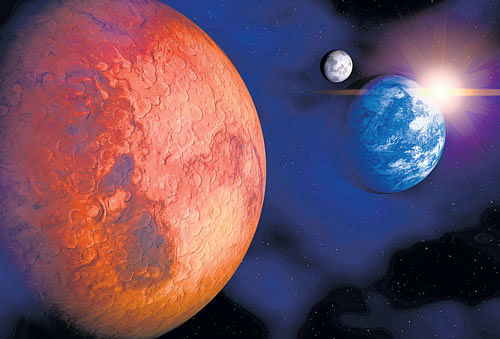
A strangely shaped depression on Mars could be a new place to look for signs of life on the red planet, according to a new study.
The depression was probably formed by a volcano beneath a glacier and could have been a warm, chemical-rich environment well suited for microbial life, researchers said.
"We were drawn to this site because it looked like it could host some of the key ingredients for habitability - water, heat and nutrients," said lead author Joseph Levy, a research associate at the University of Texas in the US.
The depression is inside a crater perched on the rim of the Hellas basin on Mars and surrounded by ancient glacial deposits.
In 2009, Levy noticed crack-like features on pictures of depressions taken by the Mars Reconnaissance Orbiter that looked similar to "ice cauldrons" on Earth, formations found in Iceland and Greenland made by volcanos erupting under an ice sheet.
Another depression in the Galaxias Fossae region of Mars had a similar appearance.
"These landforms caught our eye because they're weird looking.
They're concentrically fractured so they look like a bulls-eye. That can be a very diagnostic pattern you see in Earth materials," said Levy, who was a postdoctoral researcher at Portland State University when he first saw the photos of the depressions.
However, this year he and his research team were able to more thoroughly analyse the depressions using stereoscopic images to investigate whether the depressions were made by underground volcanic activity that melted away surface ice or by an impact from an asteroid.
Study collaborator Timothy Goudge used pairs of high-resolution images to create digital elevation models of the depressions that enabled in-depth analysis of their shape and structure in 3-D.
"The big contribution of the study was that we were able to measure not just their shape and appearance, but also how much material was lost to form the depressions. That 3-D view lets us test this idea of volcanic or impact," Levy said.
After testing formation scenarios for the two depressions, researchers found that they probably formed in different ways.
The debris spread around the Galaxias Fossae depression suggests that it was the result of an impact - but the known volcanic history of the area still does not rule out volcanic origins, Levy said.
The analysis showed that both depressions shared an unusual funnel shape, with a broad perimeter that gradually narrowed with depth.
The interaction of lava and ice to form a depression would be an exciting find, Levy said, because it could create an environment with liquid water and chemical nutrients, both ingredients required for life on Earth.
He said that the Hellas depression and, to a lesser extent, the Galaxias Fossae depression, should be kept in mind when looking for habitats on Mars.The findings were published in Journal Icarus.